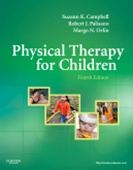Used as both a core textbook in PT programs and as a clinical reference, Physical Therapy for Children, 4th Edition,
provides the essential information needed by PTs, both student and professional, when working with children. Like the
previous bestselling editions, the 4th edition follows the practice pattern categories of the Guide to Physical
Therapist Practice and uses the IFC model of the disabling process as it presents up-to-date evidence-based coverage of
treatment. In this latest edition, Suzann Campbell DeLapp, Robert J. Palisano, and Margo N. Orlin have added more case
studies and video clips, additional chapters and Medline-linked references online, and Evidence to Practice boxes to
make it easy to find and remember important information.
--------------------------------------------------------------------------------
목차
Understanding Motor Performance in Children
1 Evidence-Based Decision-Making in Pediatric Physical Therapy
2 The Child''s Development of Functional Movement
3 Motor Control: Developmental Aspects of Motor Control in Skill Acquisition
4 Motor Learning: Theories and Strategies for the Practitioner
5 Musculoskeletal Development and Adaptation
6 Physical Fitness during Childhood and Adolescence
Management of Musculoskeletal Impairment
7 Juvenile Rheumatoid Arthritis
8 Spinal Conditions
9 Congenital Muscular Torticollis
10 Arthrogryposis Multiplex Congenita
11 Osteogenesis Imperfecta
12 Muscular Dystrophy and Spinal Muscle Atrophy
13 Limb Deficiencies
14 Orthopedic Conditions
15 Sports Injuries in Children
Management of Neurologic Impairment
16 Developmental Coordination Disorder
17 Children with Motor and Cognitive Impairments
18 Cerebral Palsy
19 Brachial Plexus Injury
20 Spinal Cord Injury
21 Brain Injuries: Traumatic Brain Injuries, Near Drowning, and Brain Tumors
22 Myelodysplasia
Management of Cardiopulmonary Conditions
23 Children Requiring Long TermVentilator Assistance
24 Cystic Fibrosis
25 Asthma: Multi-System Implications
26 Thoracic Surgery
Special Settings and Special Considerations
27 The Environment of Intervention
28 The Special Care Nursery
29 Community-based Services for Birth to Three Years
30 The Educational Environment
31 The Burn Unit
32 Transition to Adulthood for Children with Disabilities
Special Topics (Available on the companion Evolve website)
E1 Gait: Development and Analysis
E2 Genomics and Genetic Syndromes Affecting Movement
E3 Hemophilia
E4 Assistive Technology


